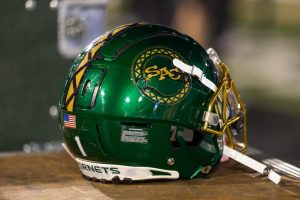Construction project to affect traffic
January 7, 2007
Sacramento State’s Facilities Services Department is gearing up to tack on another job to its list of projects next week. A 35,000-gallon sewage storage tank will be installed to replace an existing tank across the street from Parking Structure I as part of the Infrastructure II project.
The tank will provide an increased waste capacity on campus. The project will begin tomorrow and will take about six months to complete.
The project is likely to impact traffic on the westbound lane of State University Drive for the duration of the job, according to a press release. This is the street that runs parallel to the practice fields and the baseball diamond.
Associate Vice President of Facilities Services Ron Richardson said only one lane of traffic will be available during the construction, but traffic will continue to move in both directions.
Since the construction will occupy the westbound lane on State University Drive, the eastbound lane will be converted into a traffic lane that will be shared by vehicles moving in opposite directions, Richardson said. An attendant will direct traffic by dictating which vehicles must stop and which vehicles can move through.
In addition, cars traveling west ?” away from J Street and toward Folsom Boulevard ?” will be unable to make a left turn to enter Parking Structure I and will have to travel east to turn right onto Sinclair Road to enter Parking Structure I.
Senior liberal studies student Ashley Dai Zovi was unaffected by the news at first.
“I haven’t been affected by it (traffic) because I’m here 7 – 7:30 a.m.,” Dai Zovi said.
When she learned that traffic surrounding the structure was going to be impacted, she wasn’t happy.
“I only come that way, so now I’ll have to start leaving even earlier,” she said.
The construction will also affected Dai Zovi’s studying, which she likes to do while she’s outside.
“You can’t enjoy it as much anymore,” she said.
Other students didn’t take the news well either.
“I think it’s crappy,” said senior liberal studies major Kim Shores, with no pun intended. “There’s always construction.”
Students, like Shores, and junior Ian Blair, seem to agree that construction should be done during semester breaks.
“Why don’t they do that in the summer?” said Blair, a finance major. “The university really cares about us,” Blair sarcastically said.
Richardson explained that, although construction presents an inconvenience to students, it’s something that is necessary and can’t all be done when classes aren’t in session.
Richardson wants to assure students and faculty alike that builders installing the tank will strive to make the process as convenient as possible.
“Our intent is to add to our ability to service the university,” Richardson said. “The road is wide enough (near the parking structure) to keep all construction equipment off the road.”
Pedestrian and bicycle traffic will also be rerouted because of the project.
The arch tunnel where students have access through Hornet Crossing will only have access to the sidewalk on the east side of the road.
The bike trail will see a renovation upon the completion of the project. The trail will be about eight-feet wide on the west side of the drive, Richardson said. For the time being, people traveling on bikes will have to use a temporary gravel path.
Signs will also be placed along State University Drive West and Sinclair Road indicating sidewalk closures, detour routes and pedestrian and bicycle access.
Richardson said construction times will be between the hours of 6 a.m. and 4 p.m.
The 64-foot-long, 10-foot-diameter fiberglass sewage storage tank will be installed 30 feet underground and will hold sewage before its transfer to the city’s system.
It is an upgrade that Richardson said needed to be done.
The original tank, constructed in the early days of the university, was only supposed to accommodate services for a population of about 8,000, Richardson said. Today, Sac State has a population of about 27,000, according to spring 2006 enrollment statistics.
“We can’t afford to pay the city to upgrade their system,” Richardson said. The city sanitary sewage system can only take so much of the university activity, Richardson added.
The project is part of the Infrastructure II upgrade to improve the campus’ pipe system for steam, condensate and chilled water systems, expand and renovate the existing campus sanitary sewer system and replace the fire alarm systems.
The $5.4 million dollar project is being funded from a bond passed five years ago, Richardson said. Completion of the entire Infrastructure II project is slated for fall 2007.
Josh Staab can be reached at [email protected]




























































































































